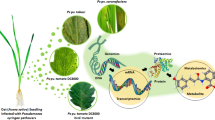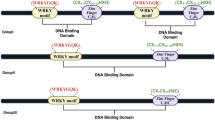Abstract
Phytophthora infestans is a hemibiotroph Oomycete that primarily infects tomato. In this study, the growth status and pathogenicity of attenuated and virulent strains of Phytophthora infestans were determined. Furthermore, RNA-seq technology was used to explore the differences in gene transcription levels between attenuated and virulent strains. Gene Ontology (GO) classification and Kyoto Encyclopedia of Genes and Genomes (KEGG) pathway enrichment analyses were performed on the differentially expressed genes (DEGs) obtained by sequencing, and the significant DEGs related to the growth and pathogenicity of the strains were screened from the significantly enriched pathways. The results revealed that compared with the virulent strain, the growth of the attenuated strain was inhibited, the structure of hyphae was destroyed, and the disease index was decreased. The differences in the growth status and disease index of the attenuated strain were related to changes in several metabolic pathways, and the DEGs in the metabolic pathways indicated alterations in the attenuated strain growth and pathogenicity. There were 2,651 DEGs in the attenuated strain, of which 1,086 were upregulated and 1,565 were downregulated. The inhibited growth of the attenuated strain was associated with accumulation of excessive glucose, decomposition of serine/glycine, and reduction of tryptophan synthesis. The reduced pathogenicity of the strain was associated with degradation of the cell wall and reduced formation of melanin and α-keto butyric acid. These results could offer insights into the mechanisms of attenuation of Phytophthora infestans.




Similar content being viewed by others
Data availability
Please contact author for data requests.
References
Altschul SF, Gish W, Miller W, Myers EW, Lipman DJ (1990) Basic local alignment search tool. J Mol Biol 215:403–410. https://doi.org/10.1006/jmbi.1990.9999
Bange FC, Brown AM, Jacobs WR (1996) Leucine auxotrophy restricts growth of Mycobacterium bovis BCG in macrophages. Infect Immun 64:1794–1799. https://doi.org/10.1128/IAI.64.5.1794-1799.1996
Bolger AM, Lohse M, Usadel B (2014) Trimmomatic: a flexible trimmer for Illumina sequence data. Bioinformatics 30:2114. https://doi.org/10.1093/bioinformatics/btu170
Chai M, Yu SC, Jiang LG (2005) Pathogenicity of a new isolate of Phytophthorainfestans from Beijing and resistance evaluation of tomato materials. J N China Agric 4:98–101
Chang Q (2017) Study of the puccinia striiformis f. sp. Tritici sugar absorption mechanism in infection of wheat. Dissertation, Northwest A&F University
Choi J, Chung HJ, Lee GW, Koh SK, Chae SK, Lee YH (2015) Genome-wide analysis of hypoxia-responsive genes in the rice blast fungus Magnaporthe oryzae. PLoS One 10:e0134939. https://doi.org/10.1371/journal.pone.0134939
Ding Z, Zhou T, Guo LY (2017) Characterization of a novel strain of Botryosphaeriadothidea chrysovirus 1 from the apple white rot pathogen Botryosphaeriadothidea. Arch Virol 162:2097–2102. https://doi.org/10.1007/s00705-017-3320-6
Du JL, Zhang JL (2000) The approach on the defensive function of hypovirulent strains to Cryphonectriaparasitica. J Agric Univ Hebei 23:82–85
Duressa D, Anchieta A, Chen DQ, Klimes A, Garcia-Pedrajas MD, Dobinson KF, Klosterman SJ (2013) RNA-Seq analyses of gene expression in the microsclerotia of Verticilliumdahliae. BMC Genomics 14:607. https://doi.org/10.1186/1471-2164-14-607
Gao SG, Li YQ, Gao JX, Suo YJ, Fu KH, Li YY, Jie C (2014) Genome sequence and virulence variation-related transcriptome profiles of Curvularialunata, an important maize pathogenic fungus. BMC Genomics 15:627. https://doi.org/10.1186/1471-2164-15-627
Gordhan BG, Smith DA, Alderton H, McAdam RA, Bancroft GJ, Mizrahi V (2002) Construction and phenotypic characterization of an auxotrophic mutant of Mycobacterium tuberculosis defective in L-arginine biosynthesis. Infect Immun 70:3080–3084. https://doi.org/10.1128/IAI.70.6.3080-3084.2002
Grabherr MG, Haas BJ, Yassour M, Levin JZ, Amit I, Thompson DA, Adiconis X, Fan L, Raychowdhury R, Zeng QD, Chen ZH, Mauceli E, Hacohen N, Gnirke A, Rhind N, Palma FD, Birren BW, Nusbaum C, Lindblad-Toh K, Friedman N, Regev A (2013) Trinity: reconstructing a full-length transcriptome without a genome from RNA-Seq data. Nat Biotechnol 29:644–652. https://doi.org/10.1038/nbt.1883
Hage H, Rosso M, Tarrago L (2021) Distribution of methionine sulfoxide reductases in fungi and conservation of the free-methionine-R-sulfoxide reductase in multicellular eukaryotes. Free Radical Biol Med 169:187–215. https://doi.org/10.1016/j.freeradbiomed.2021.04.013
Hu GS, Huang CG, Zhang Yang XW, Jia JM (2017) Accumulation of biomass and four triterpenoids in two-stage cultured Poria cocos mycelia and diuretic activity in rats. Chin J Nat Med 15:265–270. https://doi.org/10.1016/S1875-5364(17)30043-2
Hu MY, Bai WQ, Pan XX, Wu H, Ru XJ, Luo J, Yin XG, Pan GH, Lei KR (2018) Analysis of tomato late blight resistance marker based on the analogues of Ph-3 gene. Acta Phytopathology 48:560–566. https://doi.org/10.13926/j.cnki.apps.000149
Kanehisa M, Araki M, Goto S, Hattori M, Hirakawa M, Itoh M, Katayama T, Kawashima S, Okuda S, Tokimatsu T, Yamanishi Y (2008) KEGG for linking genomes to life and the environment. Nucleic Acids Res 36:D480–D484. https://doi.org/10.1093/nar/gkm882
Li MJ (2015) Functional analysis of UDP glucose pyrophosphorylase and phosphoglucomutase in the carbon metabolism of Ganoderma lucidum. Dissertation, Nanjing Agricultural University
Li MY (2020) Prevention and treatment of tomato late blight. Vegetables 4: 69–72+86+85
Liang SH, Cheng JH, Deng FS, Tsai PA, Lin CH (2014) A novel function for Hog1 stress-activated protein kinase in controlling white-opaque switching and mating in Candida albicans. Eukaryot Cell 13:1557–1566. https://doi.org/10.1128/EC.00235-14
Liu MJ, Huang QD, Long B, Wang XY, Ou QQ, Huang XQ (2019) Screening of cherry tomatoes with late blight resistance in Guangxi. Northern Horticulture 2:20–24. https://doi.org/10.11937/bfyy.20181951
Liu YS, Liu YL, Huang SQ, Niu TT, Yuan HZ, Yan XJ (2020) Influence of application volume on the efficacy of UAV low-volume-spray to control tomato late blight. Pest Sci Admin 41:46–52
Mo YR, Zhang PX, Deng MH, Yang ZA, Zhu HS, Zhang H, Bao JY, Hu WY, Tang XQ, Ma ZF, Wen L, Zhao K (2016) Research on the excavation and response patterns of genes resistant to late blight located in the No.9 chromosome of tomato. Journal of China Agricultural University 21:527–533. https://doi.org/10.11841/j.issn.1007-4333.2016.08.07
Peksen A, Kibar B, Yakupoglu G (2013) Favourable culture conditions for mycelial growth of Hydnum repandum, a medicinal mushroom. Afr J Tradit Complem: AJTCAM 10.https://doi.org/10.4314/ajtcam.v10i6.4
Qian C (2013) Study on the screening of attenuated strains for Fusarium oxysporum f.sp.cucumerinum and induced resistance on cucumber wilt after treated with parsley extracts. Dissertation, Inner Mongolia Agricultural University
Qian C, Gao XM, Bao YY, Li J, Yun XF (2013) Screening of attenuated strains for Fusarium oxysporumf.sp.cucumerinum after treated with parsley seed extracts. Chinese J Ecol 32:82–90. https://doi.org/10.13292/j.1000-4890.2013.0048
Ren JH (2009) Effect of folate pathway on accumulation of L-serine in Corynebacterium glutamicum SYPS-062. Dissertation, Jiangnan University
Roberts A, Pachter L (2013) Streaming fragment assignment for real-time analysis of sequencing experiments. Nat Methods 10:71–73. https://doi.org/10.1038/NMETH.2251
Simon A, Wolfgang H (2013) Differential expression of RNA-Seq data at the gene level—the DESeq package. EMBL
Tewodros M, Kibrom A, Habte T, Bayeh M, Mohammed Y, Erik A, Erland L, Erik A (2019) Phosphite protects against potato and tomato late blight in tropical climates and has varying toxicity depending on the Phytophthorainfestans isolate. Crop Prot 121:139–146. https://doi.org/10.1016/j.cropro.2019.03.019
Trapnell C, Williams BA, Pertea G, Mortazavi A, Kwan G, Van Baren MJ, Salzberg SL, Wold BJ, Pachter L (2010) Transcript assembly and quantification by RNA-Seq reveals unannotated transcripts and isoform switching during cell differentiation. Nat Biotechnol 28:511–515. https://doi.org/10.1038/nbt.1621
Ueda Y, Konishi M, Yanagisawa S (2017) Molecular basis of the nitrogen response in plants. Soil Sci Plant Nutr 63:329–341. https://doi.org/10.1080/00380768.2017.1360128
Wa TH (2019) Occurrence and control measures of tomato late blight. Nongjia Staff 24:58
Wang LP, Jiang JJ, Wang YF, Ni H, Zhang FP, Xu WX, Wang GP (2014) Hypovirulence of the phytopathogenic fungus Botryosphaeriadothidea: association with a coninfecting Chrysovirus and Partitivirus. J Virol 88:7517–7527. https://doi.org/10.1128/JVI.00538-14
Wei Z, Yu W (2018) One-carbon metabolism and anti-folate chemotherapeutic drugs. Chinese J Cell Bio 40:1973–1982. https://doi.org/10.11844/cjcb.2018.12.9002
Yan MX, Dai WJ, Cai EP, Deng YZ, Chang CQ, Jiang Z, Zhang LH (2016) Transcriptome analysis of Sporisoriumscitamineum reveals critical environmental signals for fungal sexual mating and filamentous growth. BMC Genomics 17:1–11. https://doi.org/10.1186/s12864-016-2691-5
Yang M (2016) Vousden KH serine and one-carbon metabolism in cancer. Nat Rev Cancer 16:650–662. https://doi.org/10.1038/nrc.2016.81
Yang WJ (2019) Melanin synthesis mechanism of Bacillus thuringiensis BMB171. Dissertation, Huazhong Agricultural University
Yao N, Liu XM, Dong YY, Wang N, Meng LL, Li HY (2017) Advances in application and sequencing methods of transcriptome. Northern Hort 12:192–198. https://doi.org/10.11937/bfyy.201712043
Yin XY, Zhang GS, Han ZZ, Li BJ, Xie XW (2016) Occurrence and prevention of tomato late blight in non-cultivated solar greenhouse. China Vegetables 5:88–89
Yu XM (2018) Comparative study on browning and related mechanisms of different strains of Tricholoma giganteum. Dissertation, South China Agricultural University
Zhang HS (2014) Transcriptome analysis of two different pathotypes of Puccinia triticinia with different virulence. Dissertation, Hebei Agricultural University
Zhao LG, Zhang Y, Zhang TM, Zhao J, Wang YL, Li M (2020) Harm and epidemiological characteristics of tomato late blight in China. Modern Horticulture 43:106–108. https://doi.org/10.14051/j.cnki.xdyy.2020.19.047
Zhao YJ (2018) The mechanism of resistance to verticillium wilt on sunflower induced by Gibellulopsis nigrescens Vn-1. Dissertation, Inner Mongolia Agricultural University
Zhi XN, Shu JS, Sun XR, Bai JR, Cui YN, Huang ZJ, Wang XX, Liu L, Du YC, Yan ZF, Li JM (2020) Screening and analysis of wild solanum pimpinellifolium species resistant to late blight. China Vegetables 2:20–29
Zhou HX (2019) Studies on function of ketol acid reductoisomerase gene (MrilvC) in Metarhizium robertsii. Dissertation, Anhui Agricultural University
Zhu XM, Han MB, Chen QY, He YT, Wang DL, Liu F, Li HK (2020) Screening test of potato late blight control agents in Xintai city. Modern Agric Sci Technol 11:114–116
Acknowledgements
The authors are grateful to prof. Xiaojing Yan from Chinese Academy of Agricultural Sciences (Beijing, China) for her kindly providing virulent strain of Phytophthora infestans. We thank LetPub (www.letpub.com) for its linguistic assistance during the preparation of this manuscript.
Funding
This work was supported by grants from the Key Projects of Applied Technology Research and Development of Inner Mongolia Autonomous Region (Grant number 201702068) and Science and Technology Achievement Transformation Project of Inner Mongolia Autonomous Region (Grant number CGZH2018140). The author of these projects is Xingfu Yun. Funding provides assistance for in the design of the study and collection, analysis, and interpretation of data and in writing the manuscript.
Author information
Authors and Affiliations
Contributions
Xingfu Yun proposed research ideas and experimental design; Jiafang Liu conducted experimental research and data analysis, and was responsible for writing the first draft of the manuscript; Lei Li and Yong Wang participated in the revision and correction of the manuscript.
Corresponding author
Ethics declarations
Ethics approval and consent to participate
Compliance with ethical standards.
Consent for publication
Not applicable.
Competing interests
The authors declare no competing interests.
Additional information
Publisher's note
Springer Nature remains neutral with regard to jurisdictional claims in published maps and institutional affiliations.
Rights and permissions
About this article
Cite this article
Liu, J., Li, L., Wang, Y. et al. Morphological and transcriptomic analysis of attenuated and virulent strains of Phytophthora infestans. Int Microbiol 25, 89–98 (2022). https://doi.org/10.1007/s10123-021-00195-9
Received:
Revised:
Accepted:
Published:
Issue Date:
DOI: https://doi.org/10.1007/s10123-021-00195-9




